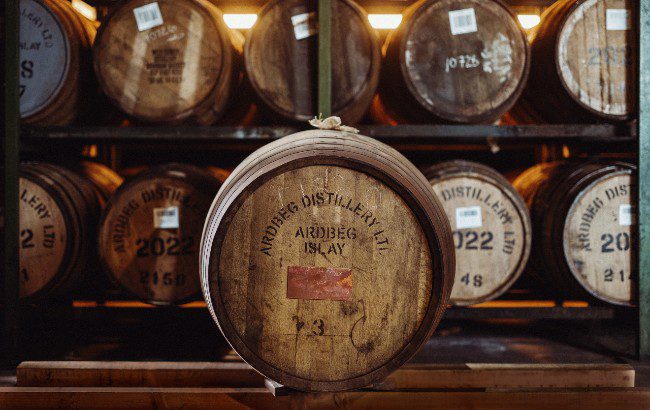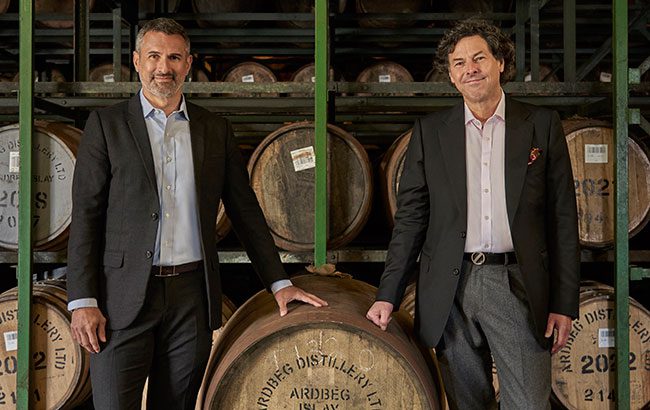How does a cask of Ardbeg sell for £16m?
Following the £16 million (US$19.3m) Ardbeg cask sale last week, the president and CEO of brand owner The Glenmorangie Company gives further details about the record-setting sale.

Last week, a female whisky collector in Asia bought a cask of Ardbeg that was distilled in 1975 for £16m (US$19.2m).
Cask No. 3 contains liquid distilled on Tuesday 25 November 1975, which was filled into a Bourbon barrel and an oloroso Sherry cask. In 2014, Ardbeg’s director of whisky creation, Dr Bill Lumsden, emptied both casks into a single refill oloroso Sherry butt.
Over the next five years, the buyer will receive 88 bottles of single malt whisky from the cask to give her a unique vertical series of Ardbeg whiskies with a 1975 vintage, aged for 46, 47, 48, 49 and 50 years.
“The first thing to say is that this is a one-of-a-kind cask in our stock; we have virtually nothing left from the 70s after the closure of the 80s,” said Thomas Moradpour, president and CEO of The Glenmorangie Company. “This is due to the fact that most of what we produced in the 70s was released for blending and very few casks were kept for single malts. Those two casks survived that troubled era up to 2014 when Dr Bill Lumsden tasted them, and found them to be exceptional, and had the thought to create an even better whisky by marrying them.”
How did the brand find the correct buyer for such a unique cask sale? “That’s a chicken and egg question,” Moradpour said. Ardbeg boasts a global fan base, called the Ardbeg Committee, with 160,000 brand lovers around the world.
The agreement with the buyer came about from a little-known initiative that has been in the works away from the public eye.
“We didn’t start with a £16m cask of whisky. We started a programme a couple of years ago, a private programme that we chose not to publicise, to sell exceptional whiskies by the cask to private buyers,” said Moradpour. “So this is a programme that started about two years ago, with casks I would say probably around 30 years old, or so, from both Glenmorangie and Ardbeg, with the prices ranging from between €200,000 and €2m.”
Due to the “successful” response to the programme, the buyer in question became well known to the company. Moradpour describes the buyer as a “collector and a very generous person with her friends and bottles”.
“We’ve seen her purchase other producers before with us, so we know her taste,” he said. “When we reviewed our whisky stocks, reviewed what whiskies we thought were ready for the next phase of this programme and considered this particular whisky, we could only offer it once.”
Comparing 1970s Ardbeg to the modern day
Ardbeg distillery manager Colin Gordon also weighed in on the uniqueness of the cask. One big difference he points out when comparing Ardbeg in the 70s to the modern-day brand whisky lovers enjoy today, is the malting of the barley.
“All barley was malted on site in 75, and then when the distillery shut in 81, the malt floors stopped. From then onwards the malt was brought in from Port Ellen,” Gordon explained. “I suppose the sort of differences you are likely to see are in consistency, today we are more consistent. What we saw with Ardbegs from the 70s was there was a bit more variation.”

When it comes to Cask No. 3, his feelings towards the liquid are clear: “It’s just an absolutely sensational liquid, and undoubtedly a 70s Ardbeg. It’s very, very special. The smoke is there, and incredibly after 46 years you’ve still got this incredible balance. The Ardbeg peaty paradox we always talk about, fruity citrus notes with the smoke, it’s been so beautifully matured, big rich mahogany notes, leathery notes, linseed oil that just adds such depth and complexity to it, it’s an amazing spirit.”
Will other casks be offered for sale in future? It seems likely, but Moradpour noted: “This will be the pinnacle of this programme; this is most likely something that we won’t be able to reproduce for quite a number of years, starting from the fact it took 46-50 years of patience to get to that.”
The sale came with a £1m donation to Islay-based causes, and the money will be shared with chosen partners on the island over the next five years.
Moradpour stressed the importance of giving back to the island and enhancing the local community. “For us this is absolutely critical,” he assured.
“My role and the role of my team is to make sure we take what has been given to us and we give it to the next generation in better shape than we got it in the first place,” he continued. “If you think about the history of Ardbeg, 25 years ago Ardbeg was nearly gone, all but dead. It had been closed down completely for most of the 80s, it closed again in the 90s, it had been acquired by the Glenmorangie company in 97, and it was rebuilt from the ashes from scratch as the sought-after whisky it is today.
“We have to make sure we can still exist, and that the community and the environment that it’s in thrives. We cannot make whisky on Islay if Islay is not a great environment. And in particular if it’s not a great environment for the community on Islay. It is our responsibility to make Islay a great place to live and have a life, and a great environment that thrives and is sustainable.”
Moradpour and his team will work with the local community over the next five years to ensure the funding is used to its “maximum potential”.
Secondary market demand
Ardbeg continues to also drive strong demand on the secondary market. Rare Whisky 101 cited the Scotch whisky brand as the second most collectable whisky in the UK, after equally weighting volume and value data for whisky sold in the UK at auction. Moradpour attributes the brand’s popularity to its innovation, “peaty paradox” and hopes it will take the top spot in the near future.
“Hopefully it will soon be number one on that ranking,” Moradpour said. “Ardbeg is made, and has always been made, with very specific care, specs, and whisky philosophy. It is the smokiest of the Islay malts but it also has this peaty paradox – it’s not all smoke, there is complexity around this taste, which Ardbeg lovers will recognise, the distinctiveness of the whisky style is a reason collectors love it.
“It’s also the creativity and whisky philosophy of Dr Bill, who endeavours to make whiskies as weird as he can in small batches. We’ve been here for 200 years as I said before, and it’s out ambition to be there for at least 200 years more.”
In other whisky-related news, The Spirits Business and Lux Row Distillers are selling a cask of Rebel Bourbon to raise money for people affected by the war in Ukraine. Here’s how you can get involved.
Related news
Golf drives Glen Moray push in UK travel retail
